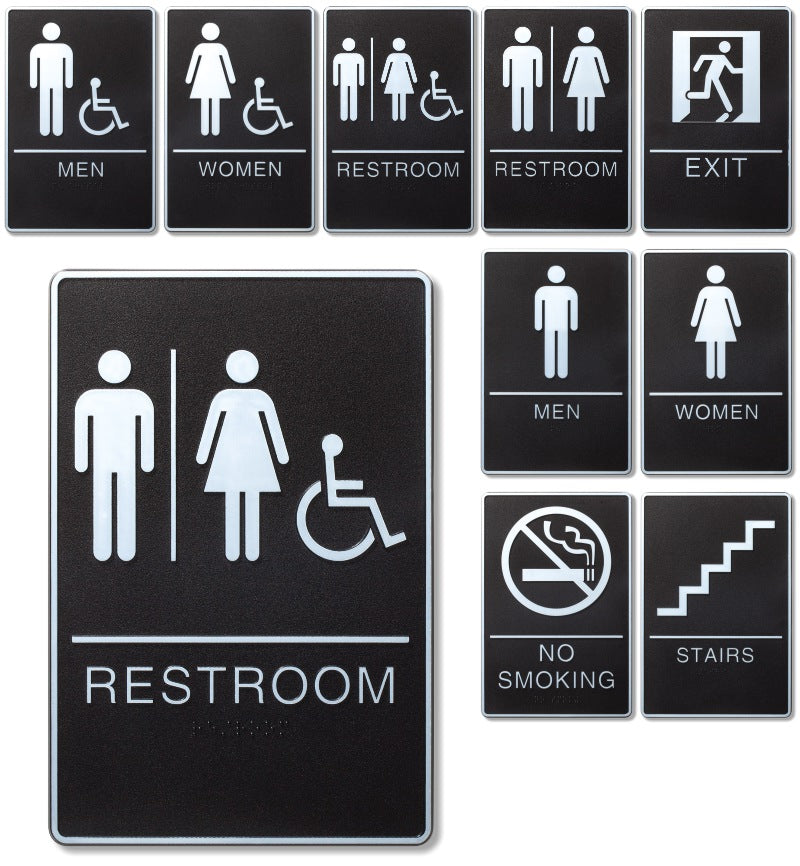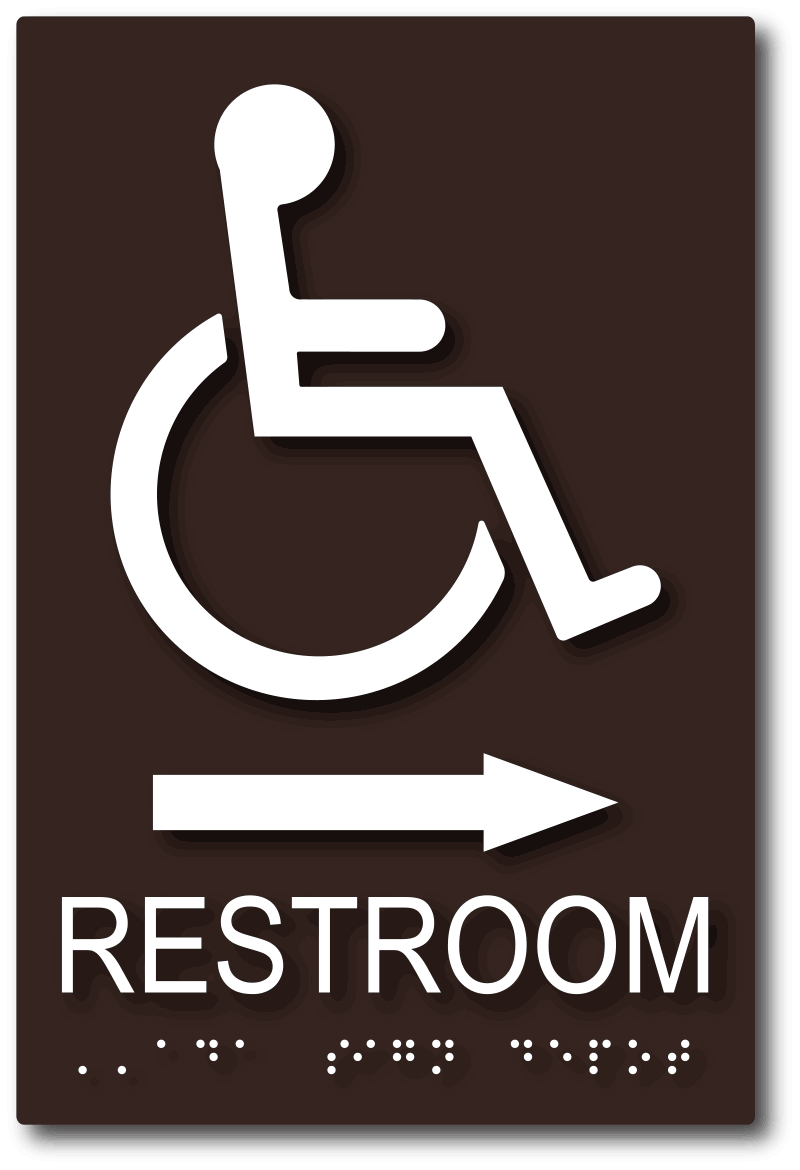Discovering Innovative Designs for Reliable ADA Signs
Discovering Innovative Designs for Reliable ADA Signs
Blog Article
Discovering the Key Features of ADA Indications for Boosted Ease Of Access
In the realm of accessibility, ADA signs offer as quiet yet effective allies, guaranteeing that spaces are accessible and comprehensive for individuals with disabilities. By integrating Braille and tactile aspects, these indicators damage barriers for the aesthetically impaired, while high-contrast shade plans and readable font styles provide to diverse visual demands.
Relevance of ADA Conformity
Making certain conformity with the Americans with Disabilities Act (ADA) is crucial for cultivating inclusivity and equal accessibility in public areas and workplaces. The ADA, established in 1990, mandates that all public facilities, employers, and transport solutions accommodate people with impairments, guaranteeing they enjoy the same legal rights and chances as others. Conformity with ADA criteria not just meets lawful commitments however additionally boosts an organization's online reputation by showing its dedication to variety and inclusivity.
One of the crucial aspects of ADA compliance is the execution of obtainable signage. ADA indicators are created to make sure that people with specials needs can conveniently navigate through rooms and buildings. These signs must comply with particular guidelines concerning size, typeface, color contrast, and positioning to ensure exposure and readability for all. Effectively executed ADA signs aids remove obstacles that people with specials needs commonly run into, thus advertising their freedom and self-confidence (ADA Signs).
Moreover, sticking to ADA policies can mitigate the danger of possible fines and lawful repercussions. Organizations that fail to abide by ADA standards may deal with charges or lawsuits, which can be both damaging and monetarily troublesome to their public photo. Hence, ADA compliance is important to promoting a fair setting for everybody.
Braille and Tactile Aspects
The unification of Braille and tactile aspects into ADA signs personifies the principles of availability and inclusivity. These attributes are important for people that are aesthetically damaged or blind, allowing them to navigate public rooms with greater independence and self-confidence. Braille, a tactile writing system, is important in supplying created information in a layout that can be easily perceived through touch. It is commonly put under the corresponding message on signs to ensure that individuals can access the information without aesthetic help.
Tactile elements expand beyond Braille and consist of increased characters and signs. These elements are designed to be noticeable by touch, permitting people to recognize space numbers, toilets, exits, and various other vital areas. The ADA establishes details guidelines pertaining to the dimension, spacing, and positioning of these tactile components to enhance readability and ensure uniformity throughout various settings.

High-Contrast Color Systems
High-contrast color pattern play an essential role in boosting the presence and readability of ADA signs for individuals with aesthetic disabilities. These plans are important as they make the most of the difference in light reflectance in between message and history, making sure that indicators are conveniently discernible, also from a distance. The Americans with Disabilities Act (ADA) mandates the use of specific shade contrasts to suit those with limited vision, making it a vital facet of compliance.
The efficiency of high-contrast shades depends on their capacity to stand out in various lighting conditions, consisting of dimly lit atmospheres and locations with glare. Typically, dark text on a light background or light text on a dark background is used to achieve ideal comparison. Black message on a white or yellow history supplies a stark visual difference that helps in quick recognition and comprehension.

Legible Fonts and Text Size
When considering the design of ADA signage, the option of readable typefaces and proper message size can not be overstated. These components are important for making certain that indications are available to people with aesthetic impairments. The Americans with Disabilities Act (ADA) mandates that font styles should be not italic and sans-serif, check my reference oblique, script, highly ornamental, or of uncommon kind. These requirements help make certain that the message is easily understandable from a range which the characters see are distinct to diverse audiences.
The size of the message additionally plays an essential duty in access. According to ADA guidelines, the minimum message height should be 5/8 inch, and it ought to enhance proportionally with seeing range. This is specifically essential in public areas where signage needs to be reviewed rapidly and properly. Consistency in message dimension adds to a natural aesthetic experience, helping people in navigating settings successfully.
Furthermore, spacing between letters and lines is essential to readability. Appropriate spacing protects against personalities from appearing crowded, improving readability. By sticking to these requirements, designers can considerably improve access, making sure that signs offers its intended objective for all people, despite their visual capacities.
Reliable Placement Strategies
Strategic positioning of ADA signage is crucial for maximizing ease of access and guaranteeing conformity with lawful criteria. ADA guidelines stipulate that indications ought to be mounted at an elevation in between 48 to 60 inches from the ground to ensure they are within the line of view for both standing and seated individuals.
In addition, indications must be put surrounding to the lock side of doors to enable easy identification prior to entrance. Uniformity in indicator positioning throughout a facility enhances predictability, minimizing complication and improving overall individual experience.

Final Thought
ADA indications play a vital function in promoting accessibility by incorporating functions that deal with the demands of individuals click site with specials needs. Incorporating Braille and tactile aspects guarantees critical details comes to the aesthetically impaired, while high-contrast shade plans and readable sans-serif font styles improve visibility throughout different lighting problems. Effective positioning techniques, such as suitable placing heights and calculated places, even more promote navigating. These elements collectively foster a comprehensive setting, emphasizing the significance of ADA conformity in making sure equivalent gain access to for all.
In the world of ease of access, ADA signs serve as quiet yet powerful allies, making sure that rooms are comprehensive and accessible for individuals with disabilities. The ADA, enacted in 1990, mandates that all public centers, companies, and transportation services suit individuals with specials needs, guaranteeing they appreciate the very same civil liberties and opportunities as others. ADA Signs. ADA signs are created to make sure that people with specials needs can conveniently navigate through structures and spaces. ADA guidelines specify that signs should be mounted at a height in between 48 to 60 inches from the ground to ensure they are within the line of sight for both standing and seated individuals.ADA indications play a crucial function in promoting access by integrating attributes that address the demands of individuals with disabilities
Report this page